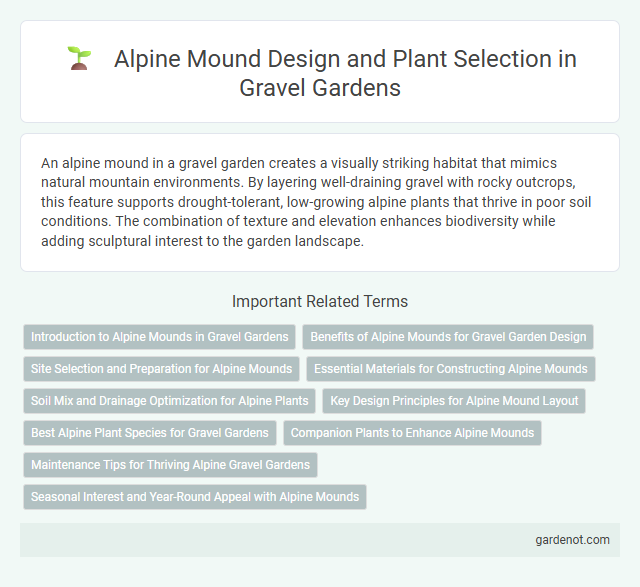An alpine mound in a gravel garden creates a visually striking habitat that mimics natural mountain environments. By layering well-draining gravel with rocky outcrops, this feature supports drought-tolerant, low-growing alpine plants that thrive in poor soil conditions. The combination of texture and elevation enhances biodiversity while adding sculptural interest to the garden landscape.
Introduction to Alpine Mounds in Gravel Gardens
Alpine mounds in gravel gardens create ideal conditions for drought-tolerant, low-maintenance plants by replicating rocky mountainous habitats. These raised features improve drainage and soil aeration, essential for alpine species such as saxifrages, sedums, and sempervivums. Incorporating an alpine mound enhances garden aesthetics while supporting biodiversity and plant health in gravel garden designs.
Benefits of Alpine Mounds for Gravel Garden Design
Alpine mounds enhance gravel garden design by improving drainage and preventing waterlogging, essential for drought-tolerant plants. Their elevated structure creates microclimates that support diverse alpine species, promoting biodiversity. These mounds also add visual interest through varied textures and heights, complementing the minimalist aesthetic of gravel gardens.
Site Selection and Preparation for Alpine Mounds
Alpine mounds thrive best in well-drained, sunny locations with minimal frost pockets to mimic their natural mountainous habitat. Site preparation involves creating a raised bed with a mix of gritty, alkaline soil enriched with organic matter to ensure proper drainage and nutrient balance. Incorporating coarse sand and small stones enhances aeration and prevents waterlogging, which is crucial for the health of alpine plants.
Essential Materials for Constructing Alpine Mounds
Essential materials for constructing alpine mounds include well-draining gravel, coarse sand, and decomposed granite to ensure optimal soil aeration and water runoff. Incorporating a base layer of larger stones promotes stability and mimics natural alpine environments, while adding a soil mix enriched with organic matter supports the growth of hardy alpine plants. Selecting drought-resistant, low-maintenance plants adapted to rocky, nutrient-poor conditions completes the effective design of a thriving gravel garden alpine mound.
Soil Mix and Drainage Optimization for Alpine Plants
Alpine mounds require well-draining soil mixes consisting of gritty sand, coarse gravel, and organic matter to mimic high-altitude conditions. Optimal drainage prevents root rot and supports the specialized needs of alpine plants, which thrive in fast-draining substrates with low water retention. Incorporating materials like pumice or perlite enhances aeration and moisture control critical for successful alpine mound gardening.
Key Design Principles for Alpine Mound Layout
An effective alpine mound layout emphasizes well-draining, rocky soil to replicate natural mountain habitats, ensuring plant health and growth. Strategic layering involves placing taller, robust alpine species at the center or rear, with smaller, delicate plants toward the edges for optimal visibility and microclimate benefits. Incorporating varied textures and colors through diverse rock sizes and alpine flora enhances aesthetic appeal while mimicking an authentic alpine environment.
Best Alpine Plant Species for Gravel Gardens
Alpine mounds thrive with hardy, low-maintenance species such as Sedum spurium, Saxifraga oppositifolia, and Androsace sempervivoides, which excel in well-drained, rocky soil conditions typical of gravel gardens. These plants offer drought tolerance, vibrant blooms, and compact growth habits, ensuring year-round visual interest and minimal water requirements. Incorporating species like Draba bryoides and Eritrichium nanum enhances biodiversity while maintaining the structural integrity and aesthetic appeal of gravel garden alpine mounds.
Companion Plants to Enhance Alpine Mounds
Selecting companion plants such as saxifrage, sempervivum, and sedum enhances alpine mounds by providing contrasting textures and colors, which mimic natural mountain habitats. These drought-tolerant species improve soil drainage and compactness, crucial for the health and longevity of alpine plants. Incorporating low-growing herbs like thyme or creeping phlox adds seasonal blooms and supports pollinators, enriching the gravel garden ecosystem.
Maintenance Tips for Thriving Alpine Gravel Gardens
Alpine mounds in gravel gardens thrive with well-drained soil and minimal watering to prevent root rot. Regularly removing debris and dead foliage helps maintain plant health and reduces disease risk. Applying a light mulch of gravel enhances moisture retention while preserving the natural alpine aesthetic.
Seasonal Interest and Year-Round Appeal with Alpine Mounds
Alpine mounds provide exceptional seasonal interest with vibrant blooms in spring and summer, while their evergreen foliage adds texture and color in winter. These well-drained, rocky mounds mimic natural mountain habitats, supporting drought-tolerant alpine plants that thrive with minimal care. Year-round appeal is enhanced by varied plant shapes, colors, and heights, creating dynamic visual interest through every season in a gravel garden setting.
Alpine mound Infographic

 gardenot.com
gardenot.com